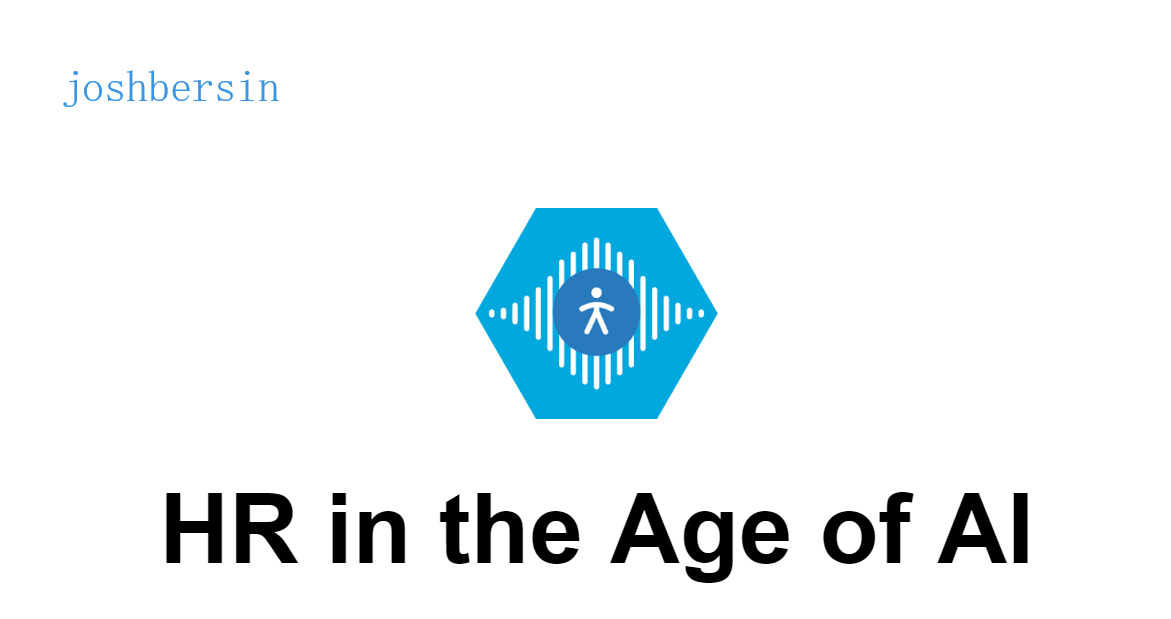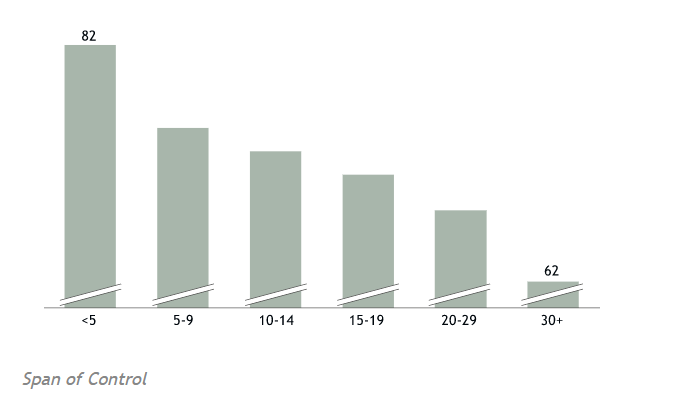People Analytics
大师谈:AI时代的人力资源:未来有很多变化,42%的员工不认为现有的HR能够胜任这一变化!
编者注:这是Josh Bersin 的观察,与HRTechChina年初发布的年度预测基本一致。其中挑战性是我们没有想到的。尤其是HR的角色能否胜任科技带来的竞争优势,帮助组织和员工快速建立这种优势,不少员工和老板不认为目前的HR能够胜任,以及觉得应该调整和改善这个角色。前瞻性的HRTechChina的用户们,你们走在了前列,看到了趋势和变化,接下来让我们一道迎接这个挑战和变化吧!
Josh Bersin在过去的几个月里,我与数十位人力资源主管讨论了他们的人才挑战和转变人力资源的必要性。
公司正在重新设计角色和重新组建团队,努力提高员工的参与度和幸福感,创建新的反馈项目,并重新思考领导力的角色。
但这些挑战中,没有一个比AI人工智能的爆炸性影响更具变革性和破坏性。
在我早期对人工智能的讨论中,我称它为“杀手级应用”,因为它有潜力改变我们所做的一切。今天,人工智能已经渗透到我们的生活中,改变了我们购物、开车、交流和管理健康的方式。随着人工智能的应用不断增长,人们的新想法和投资也在不断增加。(软银刚刚向人工智能投资了1080亿美元)。
但是,尽管许多供应商大肆宣传,人工智能并不是你“买来的”东西。“相反,我们使用的所有技术都嵌入了人工智能。人工智能工具利用数据(你必须有高质量的数据来让人工智能工作)以更智能的方式预测、建议、推荐、告知和回答人们。
现在很多公司都在大力投资人力资源领域。例如,IBM重新设计了其人力资源服务交付策略,利用智能代理帮助员工和经理回答问题,并就角色、职业、薪水和学习做出决策。
联合健康集团正在建立一个图形数据库,该数据库使用人工智能来识别提高生产力和服务质量的机会。
McKesson正在使用人工智能来了解员工关系,并提高多样性和团队效率。
作为人力资源领导者,人工智能将改变我们接触的每一个过程。我们招募、评估、雇佣、培训、开发、支付和调动人员的方式都是由AI人工智能决定的。
例如,上周,我促成了与人力资源高管的一次会议,重点讨论了人力资源业务伙伴角色的变化。这一关键角色正受到AI人工智能驱动的聊天机器人chatbot和智能平台的根本性影响,这些平台使员工和管理者越来越容易直接获得他们需要的信息。
不幸的是,许多人力资源组织没有为未来的变化做好准备。Harris Insights进行的一项全球研究发现,尽管超过80%的美国和英国员工认为拥有人工智能技能将为他们的公司带来竞争优势,但42%的人表示,他们不认为人力资源部门能够执行这一任务(真是一个不好的消息)。
普华永道(PwC)对首席执行官的一项调查发现,63%的受访者正根据新的人工智能技术和劳动力需求,重新考虑人力资源部门的角色。
人力资源部门现在有责任建立信任系统、智能系统,以及更好的预测系统,以帮助人才做出决策。我在商界的老朋友之一里奇•休斯(Rich Hughes)(联合健康集团(United Health Group)人力资源战略主管)正在一个图形数据库中构建一个包含大量员工数据的数据湖,以帮助公司更好地理解、预测和提高客户服务、索赔和其他数十个领域的绩效。摩根大通和其他公司也在做同样的事情——这就是人力资源的发展方向。
为了达到这一目标,我们必须做好准备,应对人力资源所有职能领域以及业务本身的全面中断。在我做分析师的25年里,我目睹了许多革命性的变化。我相信人工智能将是最具影响力的改变。
以上由有道翻译软件完成,感谢中国翻译软件!推荐有道翻译,更地道
原文来自:https://joshbersin.com/2019/07/hr-in-the-age-of-ai-lots-of-change-ahead/
People Analytics
People Analytics
长篇经典:人力资本分析和AI的四个信任的维度-Josh Bersin
编者注:这是一个长篇的文章,谈AI和People Analytics在工作场所中的几个核心的问题:信任的四个维度:隐私、安全、偏见、人的影响。值得思考!
尤其是HR开始新的数字化时代。请记住,信任是我们今天业务中最重要的事情之一。如果发生不好的事情,你不仅会失去工作,而且对公司声誉的损害可能是巨大的。
原标题:People Analytics and AI in the Workplace: Four Dimensions of Trust
作者:Josh Bersin
以下由AI翻译完成,仅供传递信息,原文请访问文末
AI和People Analytics已经很火了。正如我过去所写的,工作场所已成为一个高度数字化的地方。公司使用调查和反馈工具来获取我们的意见,新工具监控电子邮件和我们的通信网络(ONA),我们捕获有关旅行,位置和移动性的数据,组织现在拥有关于我们的健康,健康和健康的数据。
此外还增加了一个新的数据流,其中包括视频(每个视频会议都可以录制,超过40%的工作面试被录制),音频(记录会议的工具可以感知心情),以及识别面部的图像识别。
在人力资本分析的早期,公司捕获了员工数据,以衡量控制范围,绩效评级分布,继任管道和其他与人才相关的主题。今天,随着所有这些新信息进入工作场所(几乎在工作中点击的任何地方存储在某个地方),人员分析的领域变得非常个性化。
虽然我知道人力资源专业人员认真对待道德和安全工作,但我想指出一些我们需要考虑的道德问题。
数据滥用的风险
首先,让我给你一点动力。虽然您可能会从人力资源软件公司购买一个出色的新员工参与工具或“保留风险预测器”,但这些新系统会带来风险。当您购买系统时,您实际上不知道它是如何工作的,因此它所做出的每一个决定,建议或建议都会成为您组织的问题。
例如,假设您使用Pymetrics,HireVue(编者注:视频面试的工具)或其他高级评估技术来评估求职者。虽然这些供应商努力消除工具中的种族,性别和代际偏见,但如果您实施这些偏见并且候选人起诉您,您的公司应负责任。这种情况一直都在发生。(了解亚马逊如何无意中创建了自己的性别偏见的招聘系统。)
我就遇到过这种事情。多年前我们邀请一名秘书职位的候选人面试,但是我当天不得不离开办公室。候选人来到办公室,我们的办公室经理告诉她我们必须重新安排面试。她立即起诉我们歧视,因为她是受保护阶层的成员。我感觉很糟糕,我们付出了她的时间,但我能看出她的感受。
我要指出的另一个例子。一家公司从他们的HCM系统打开“保留预测器”告诉我,他们的经理看着这些评级,并在看到飞行风险时做各种奇怪的事情。一些管理人员实际上不再与这些人交谈并减少他们在工作中获得的支持,因为我猜他们认为“他们正在考虑离开。”显然,这不是良好的管理,但如果我们不好好利用这些数据,人们可以错误地使用它。
当然,还有其他可能出错的事情。如果您可以访问员工健康数据并使用它来评估或讨论员工的表现,我确信您处于合法危险之中。(我不是律师。)如果您泄漏或无意中发布了员工健康数据,则违反了HIPAA规则。
有很多很多地方可以解决问题。只要看看Facebook,Equifax,万豪以及其他所有认为他们都在保护数据的大公司的情况。人们犯错误; 员工做坏事; 我们必须保护数据,算法和管理行为。
随着人工智能变得越来越普遍,我们不再看到数据,而是看到“轻推”或“推荐”。如果“轻推”在某种程度上有偏见而员工变得心烦意乱怎么办?你知道这个软件是如何运作的吗?你可以回过头来确保它没有根据一些不正确的标准进行区分吗?
最后,如果您是分析师并且自己进行分析,您是否准备好在攻击下捍卫您的调查结果和建议?如果有人挑战您的发现并希望按年龄,性别,种族,甚至地点或季节了解数据 - 您是否已准备好确保其有效和可靠?我知道这是我们可以用统计工具做的事情,但我们必须要小心。
请记住,信任是我们今天业务中最重要的事情之一。如果发生不好的事情,你不仅会失去工作,而且对公司声誉的损害可能是巨大的。
我们应该做什么?
我在这个领域做了很多工作,包括花费相当多的时间与IBM,O'Reilly的人们,当然还要与许多人力资源领导者,人员分析领导者和供应商交谈。为了帮助您通过人员分析了解道德问题,让我提出以下框架。
首先,您使用的数据和算法是否公平?它是否准确反映了您想要的性能或生产率数据,而不排除,区分或无意中偏差结果?这很棘手,我将在下面讨论。从这个框架可以看出,道德有两个方面。
二,数据系统和算法安全吗?我们是否在保护隐私,机密性和安全性?谁有权访问,我们如何审核其在公司中的使用和路径?
这是IT中一个众所周知的问题,但现在我们必须处理人力资源问题。
当您查看这两个维度时,您基本上会发现有四个维度需要信任。
要考虑的第一个道德问题是隐私。如上图所示,Facebook,CVS,雅虎等公司在这里遇到了麻烦。当员工加入您的公司时,他们会授予您收集大量数据的权利,但我们作为雇主无权披露此数据,共享或将其与个人识别的信息相关联。
1.隐私
在GDPR规则中,如果员工要求,组织也必须“忘记”这些数据,因此需要考虑一些重要的业务实践。如果你看一下上面的一些问题,他们都会处理披露和保护问题。谁可以访问这些数据并让这些人接受过隐私规则和程序方面的培训?
在Deloitte,所有顾问都会参加强制性的隐私年度课程,我们的PC被扫描,我们接受培训,不会以可以披露的形式存储任何客户信息。就人力资源而言,我们需要告诉员工我们正在收集哪些数据,并确保他们理解这些数据是用于积极目的的。
虽然我们中的许多人可能会觉得在社交媒体和其他地方分享我们的个人故事很舒服(我个人不这样做),但其他人则更加私密 - 因此即使是内部员工目录也可能存在问题。一家大型科技公司最近告诉我一个关于工程师的故事,该工程师创建了一个内部社交网络,该网络显示了曾在哪个办公室工作的员工以及他们过去的工作。员工们很不高兴“发现”这个网站,因为他们没有事先征求意见,抗议其使用。该员工只是一名试图让公司成为更好工作场所的工程师,不得不关闭系统。
并且捕获的数据量不断增加。例如,L&D中增长最快的领域之一是虚拟现实(现在称为沉浸式学习)。VR程序捕获所有类型的个人表现数据 - 您的注意力范围,眼球运动以及您应对压力的能力。Pymetrics评估测量您的冒险能力和认知处理。这种类型的数据可能对目的有用(培训,工作适合),但如果不保密,也可能被滥用。
告诉别人您正在做什么,解释您的“选择加入”政策,并确保您为所有员工数据制定了良好的隐私政策。(GDPR规则要求您获得此类同意,并且您还允许员工查看您收集的数据。)
2.安全
隐私的姐妹是安全。数据是否存储和保护在其他人无法找到的地方?您是否拥有密码策略,加密和其他数据保护措施,以便员工无法将数据带回家,将其发送给第三方或意外将其发布到互联网上?这些是所有公司必须处理的IT问题,当我们收到诸如薪资,工作经历,医疗保健数据和其他个人信息等敏感信息时,我们必须妥善保护。
在欧盟,这已成为一项法律。GDPR规则之一是需要创建数据保护官并设计您的系统以进行数据保护。如果发现贵公司在这些地区失效,您可能会被罚款高达收入的2%,这是一个巨大的风险。
3.偏见
我们在People Analytics中遇到的第三个也是最困难的(也是最新的)问题是偏见。无论您是自己分析数据还是从供应商处购买AI工具,我们都必须记住所有算法系统都基于现有数据。如果现有数据存在偏差,则预测和建议将存在偏差。
这是一个非常难以解决的问题,许多组织正在努力解决这个问题。(IBM Research有关于此主题的精彩视频。)例如:
试图评估公平薪酬的系统会将员工与同行进行比较,但可能无法理解种族,地点和年龄等问题
预测保留的系统可能会歧视少数群体或因文化原因离开公司的其他人
评估适合工作的系统可能会使嵌入招聘历史的旧的,有鉴别力的招聘实践制度化
使用组织网络分析来识别绩效的系统可能没有意识到性别或年龄在信任和关系中起着重要作用
预测表现优异者的系统将偏向现有的高评价个人(可能是白人)。
您购买或构建的每个预测分析系统都会内置偏见。(“偏见”一词的意思是“基于过去的影响”,这正是AI试图做的事情。)
您可以采取的减少偏见的最佳方法是监控和培训您的分析系统。换句话说,查看它所做的预测和建议,并检查结果是否有偏差。亚马逊发现其招聘机器人偏向于女性。IBM通过“机器人培训师”不断监控其内部薪酬推荐引擎和在线管理教练(均由Watson提供支持),他们不断调整系统以应对新情况。
我记得几年前一家公司告诉我,中国的薪酬政策效果不佳,中国的工资增幅是美国的两倍。您的系统可能不知道这一点,因此它可能会偏向于中国的加薪或过度偏向美国的加息。这些不一定是不道德的决定,但这种偏见会伤害你的公司。
供应商非常关注这一点。Pymetrics对此非常认真,公司现在开放其算法来减少偏见。其他供应商应该这样做。
当我们巧妙地训练历史数据的算法时,我们在很大程度上只是重复过去。......我们需要做更多,这意味着检查数据中嵌入的偏见。 - 凯茜奥尼尔,“数学毁灭武器”
你能做什么?监控,评估和培训您的数据驱动系统。例如,IBM率先使用人工智能来帮助改善职业发展,管理实践和薪酬。该公司定期审查其基于Watson的人力资源预测员,并培训他们更聪明,更少偏见。(IBM告诉我,他们基于AI的人力资源聊天机器人现在可以在问题答案中提供超过96%的员工满意度。)
可解释,透明或可信的AI
人工智能社区有一个重大的变化,就是让系统“可以解释”。例如,为什么系统会推荐这个工资变化呢?如果您了解预测的原因,您可以更智能地对其进行操作。
4.人的影响力许多供应商正在构建检测AI偏差的工具,包括IBM的偏差检测云服务,来自Pymetrics的Audit AI。麻省理工学院的研究人员现在发布了自动偏置检测 以及 消除AI偏差而不会降低精度的方法。作为人力资源系统的买家,您应该询问这些功能。
信任的第四个维度可能是最重要的。您对捕获此数据的意图是什么?
正如GDPR规则 明确指出的那样,捕获数据以“看看它可能告诉我们什么”是不行的。如果员工认为他们因错误的原因受到监控,那么影响将是负面的。因此,我相信您应该坐下来记录为什么要捕获给定的数据流并清楚地为项目设定目标。Facebook显然没有在他们的业务中做到这一点,他们仍然在恢复声誉受损。
要问的最大问题是:为什么要实施这种特定的分析或AI工具?它会帮助人吗?还是用于监控或秘密进行绩效评估?
大多数供应商都有最好的意图。
Phenom People的新人才体验平台使用AI帮助求职者找到合适的职位空缺,帮助内部求职者找到合适的工作,并帮助聊天机器人向您提出智能问题,以了解您的工作需求。
Glint的新经理Concierge使用AI推荐行为变化和课程,以帮助您成为更好的领导者。ADP的Compass工具和CultureAmp的Zugata也是如此。Humu正在为团队和运营绩效做这件事。
来自IBM的Watson Candidate Assistant使用您的简历来确定您作为求职者的技能,并找到最佳工作,大大提高招聘质量和聘用时间。
EdCast,Valamis,Fuse和Volley正在使用AI推荐学习内容,BetterUp使用AI为您找到最好的教练。
Oracle,Workday和SuccessFactors使用AI来实现许多功能。Oracle HCM建议调整工资,甚至根据您自己的角色和行为自定义您看到的屏幕,从而简化系统本身。
像Spring Health这样的供应商现在使用AI来诊断您的心理健康并推荐正确的提示,辅导员或医生。
事实上,我很清楚所有人力资源技术供应商都在推动人工智能对人们的积极影响。然而,作为买家,我们必须确保我们能够很好地使用它。
举个例子,这里有一些要避免的事情:
不要使用监控数据秘密通知绩效评估。例如,一家金融服务公司使用一种热量和运动检测器来确定谁进入办公室。雅虎着名审查了VPN日志,以了解人们何时在家工作以及何时没有人工作。这类活动会损害员工的信任感,几乎总会导致糟糕的决策。
不得将任何形式的福利数据用于法律允许的任何其他目的。将某些健康数据用于保险定价是合法的:将其用于继任计划,绩效评估或任何其他形式的员工辅导是不合适的。
不要将训练数据(程序性能)用于性能评估。这不仅会降低信任度,还会使您陷入法律危险之中。
不要跨越个人和专业数据之间的界限。如果您正在跟踪员工手机中的数据,请确保您不会授予他人访问个人信息的权限。虽然该设备可能归公司所有,但侵犯隐私会让您陷入困境。
事实上,在大多数大公司中,在开始捕获数据之前应该进行法律审查。您的项目是否符合GDPR指南,HIPAA规则和其他机密性保护?
还要记住,基于AI的调度和工作供应问题也是有风险的工具。例如,万豪公司实施了一个新的系统来安排管家,并结束工会劳资纠纷,因为工人受到不公平对待。该系统正在推动管家疯狂地从一个房间跑到另一个房间。换句话说,它不是为了“帮助人们”,而是为了“帮助公司”。
我可以给出的简单建议是:将您的分析程序专注于对人产生积极影响的策略。如果您正在跟踪人员以衡量工作效率,并且数据将用于改善工作,那么您就会朝着正确的方向前进。如果您使用这些数据来淘汰低绩效企业,那么您可能违反了公司的管理原则。
底线:使用良好的意识,考虑道德是一个“安全”问题
越来越多的公司聘请了“ 首席道德官 ”和其他工作人员来帮助完成这些项目。其他人正在创建“道德使用委员会”,以确保所有分析项目都经过仔细评估。所有这些都是重要的想法。
就像多样性和包容性更像是“安全计划”而不是“培训问题”,数据的道德使用也是如此。最多元化的组织使用指标和委员会来确保他们的D&I战略得到加强。我们必须在道德使用员工数据方面做同样的事情。
当您启动新的分析程序时,您需要一份需要考虑的问题清单。问问自己“如果这个节目出现在纽约时报的头版上会怎么样?”这会损害公司的声誉吗?
如果答案是肯定的,你需要做更多的功课。
最后,让我们以数据为导向使用消费者体验。暴露大量消费者数据的公司遭受了可怕的打击。
今天,信任是我们拥有的最重要的商业资产之一。认真对待并确保您努力使管理数据驱动朝着正确的方向发展。你会很高兴的。
原文来自:https://joshbersin.com/2019/05/the-ethics-of-ai-and-people-analytics-four-dimensions-of-trust/
再次说明,翻译来自AI,仅供参考学习~
People Analytics
People Analytics
必读:HR如何在不成为数据专家的情况下提高自己的分析能力
How you can improve your analytical abilities without become a data expert
本文的作者是来自犹他州立大学的Mike Ulrich教授,ThinkTank学术负责人和Victory Through Organization的作者。
人力资源分析不仅仅与分析有关 - 您可以在不成为数据专家的情况下提高分析能力。
我曾经与一支训练有素的统计人员和人力资源教授一起从事人力资源分析项目。我们的目标是梳理数十万个观察结果,以预测员工选择的健康保险计划。
在我们的第二次每周会议开始时,一位统计学家同事顺便提到她的机器学习算法找到了一个变量,它解释了超过95%的营业额差异。这是令人难以置信的 - 在短短两周内,她意外地找出了营业额的主要原因,公司和研究人员花费了数十年时间试图破译。
我的另一位人力资源同事和我立即开始梦想这些重大发现所带来的出版物和咨询机会。直到她告诉我们,公司是否提供宠物保险是一个神奇的变量,这让我们质疑我们的统计学家朋友对人和人力资源的了解程度。唉,经过一番探索,宠物保险并不是我们所希望的灵丹妙药。
这个故事突出了人力资源分析的一个重要原则,经常被忽视:分析不是分析数据或现代计算技术; 分析是关于使用数据获取洞察力,以实现更好的决策和绩效。没有结构化决策过程的分析就像试图在没有糖的情况下烘烤蛋糕 - 它可能在外面看起来不错,但最终会让你想要更多。
如果我有一个小时来解决问题,我会花55分钟思考问题,5分钟思考解决方案- 阿尔伯特爱因斯坦
您如何改善基于证据的决策思维?
无论您的正式角色如何,分析思维都可以改善您的绩效和决策。成为具有分析意识的人力资源专业人员不会在一夜之间成为现实,您可能永远不会成为分析的每个部分的专家,但通过刻意的努力和培训,您可以开始将分析和基于证据的技能融入您的日常工作中。日活动。
虽然每个分析项目都不同,但研究表明有些原则可以产生更好的结果。
请记住,分析应该用于收集和评估证据,以便做出具有实际业务影响的决策。循证管理可能不是时髦,但它会产生更好的结果。
花时间在项目开始时1)确定要问的正确问题; 2)理解,重构和定义项目希望解决的问题; 3)如何实施项目的结果; 4)从决策者那里购买
了解数据和统计数据的局限性。糟糕的数据可能会产生有趣的结果,但无法改善业务。例如,主观数据(例如,参与度,净推动者得分)远远低于客观数据。
偏见是所有科学中固有的,但不要让它阻止你倾听那些偏见与你不同的人。当我们只听取同意我们现有意见的人时,我们会失去视角并限制创造机会。
并非团队中的每个人都需要擅长数据科学或统计学。仅仅因为有人在大学中对统计学或傻瓜研究方法的介绍失败并不意味着他们无法为分析项目增加价值。我最有用的同事之一并不知道平均值和茄子之间的区别,但却具有提出问题和重构问题的难以置信的能力。
如果您无法讲述数据的故事,那么找到惊人的结果并不重要。没有伴随故事,数据不会改变思想。
这些只是您开始为人力资源分析建立更好的个人能力和业务能力的众多方法中的一小部分。
人力资本分析论坛希望能够更好地了解这些主题以及您可以使用分析来实现真正业务影响的其他方式。
以上由AI翻译,仅供参考。
People Analytics
People Analytics
数字时代,你老板比你想象的更了解你!各种数字化的信息收集以及分析工具,如何在隐私和组织之间做好平衡
编者注:我们不妨看看下面这个观点,数字时代,各种原本不相干的信息,或者之前线下的信息很容易通过线上的方式数字化存储,同时可以很方便的对应到每个员工个人。可以说你一天的痕迹和工作毫无秘密可言,尤其通过数据分析更容易得到一些结论。我们一起来看看这篇文章。
以下由AI翻译完成,旨在快速传播资讯,具体可以参考文末的英文。
作者: Sarah Krouse
--雇主正在挖掘他们的员工生成的数据,以确定他们应该做什么,以及与谁合作。而作为员工的你几乎无能为力。
您的雇主可能比您想象的更了解您。
在会议中你的声音。你经常离开办公桌的频率。您多快回复电子邮件。你在办公室里漫游的地方。你的电脑屏幕上有什么。
成为美国大公司的员工现在通常意味着成为一个劳动力数据生成器 - 从早上在床上发送的第一封电子邮件到午餐时使用的Wi-Fi热点,再到回家之前添加的新业务联系人。雇主正在解析这些互动,以了解谁是有影响力的,哪些团队最有效率,哪些是飞行风险。
在美国拥有广泛法律自由度来监督员工的公司并不总是告诉他们他们追踪的是什么。当McKesson公司的高管想知道为什么它的一些团队有更高的营业额时,药品批发商去年与一家人事分析初创公司一起检查发件人,收件人和超过1.3亿封电子邮件的时间 - 而不是邮件的内容 - 来自超过20,000名美国员工,看看它可以连接关于人际关系的点。
分析公司TrustSphere发现,营业额较低的团队通常在公司内部和外部联系人的指挥链上下有各种各样的内部联系,而营业额较高的团队在公司外部拥有更强的关系,与之关系较弱。公司内部或同等级别的同事。McKesson表示,它只关注员工群体,而不是尊重员工隐私的个体员工,并且当时没有向员工透露分析,因为它没有查看电子邮件内容。
McKesson的劳动力规划和分析副总裁RJ Milnor说:“我们从中获得的信息就是让我们的团队更好地运作的信息。”
McKesson尚未确定调查结果将会发生什么变化,但考虑采用更开放的办公计划来鼓励员工之间进行更多讨论。它还在探索如何根据关系模式预测哪些团队面临失去成员风险的方法。
这不仅仅是正在计算和分析的电子邮件。公司越来越多地通过文本,Slack聊天,以及在某些情况下,在移动设备上记录和转录电话。
微软 集团 相符就利用自身的Office 365服务来衡量员工的工作效率,管理效能和工作生活平衡的聊天记录,电子邮件和它的员工和客户之间的会议频率数据。
跟踪电子邮件,聊天和日历约会可以描绘出员工每周平均花费20个小时的工作时间的情况,专注于工作场所分析的微软总经理Natalie McCollough说。该公司只允许管理人员查看五个或更多工人的团体。
今年早些时候,微软销售团队成员收到了个性化的仪表板,展示了他们如何花时间,经理们无法看到的洞察力。该门户网站提供了有关如何建立联系网络以及将更多时间花在客户而非内部会议上的建议。
微软还向其他公司销售这种类型的工作场所分析软件,例如 Macy 公司, 该公司通过衡量员工花费多少小时发送电子邮件并在工作时间以外登录来处理员工工作与生活平衡的数据。抵押贷款巨头 房地美 使用微软的分析来衡量工人在会议上花费的时间,并试图确定其中一些聚会是否多余。
在工作场所使用监控技术的倡导者表示,这些洞察力可以让公司更好地分配资源,更早地发现问题员工并使高绩效员工脱颖而出。批评者警告说,激增的工具可能不会有足够的细微差别,导致公正,公平的判断。
“为了维持与员工的信任关系,你需要做些什么是合法的,你需要做些什么,而且他们并不总是一样的,”劳动力研究和咨询公司RedThread Research的联合创始人Stacia Garr说道,该公司为公司提供研究和建议。与人力资源有关的问题。
戴安娜·哈伯德(Diana Hubbard)是德克萨斯州沃思堡市一位41岁的用户体验设计师和研究员,她根本没有在工作设备上谈论她的私人生活 - 甚至没有在网上预订晚餐。除了工作发布的手机和电脑之外,她还拥有一台个人智能手机和两台个人笔记本电脑 - 一台专门用于游戏的笔记本电脑。当她去上班时,Hubbard女士有时携带两部手机和两部笔记本电脑,并避免将她的个人电话连接到任何企业Wi-Fi,除非她建立虚拟专用网络连接。
戴安娜·哈伯德(Diana Hubbard)除了工作发行的手机和电脑外,还有个人智能手机和两台个人笔记本电脑,以保护隐私。 照片: JONATHAN ZIZZO为华尔街日报
“我不是所有的锡帽或任何东西,”她说,并指出她试图避免在线共享个人数据。“数据非常有价值,我不想免费赠送它,无论是谁试图接受它或访问它。这真的是它归结为什么。这是我的。我拥有它。“
多年来,公司已经让工人签署技术协议,详细说明流过工作机器或计算机的数字传输是公司财产的。就业律师说,美国雇主在法律上有权获得在工作场所或他们为雇员用于工作的设备上创建的任何通信或知识产权。
HR是否考虑下你应该了解和学习以及掌握这种数字分析或者人力资本分析的方法?起码你知道边界在哪里,在组织和员工之间找到一种平衡。否则数字时代我们是否会被抛弃?
现在,公司越来越聪明地分析他们拥有的工人数据库。其中一个最新的领域是解析电话和会议室对话。在某些情况下,音调分析可以帮助诊断团队中的文化问题,显示谁主导对话,谁反对,谁拒绝参与情感讨论的努力。
Life Time Inc.经营着一系列健身设施,使用由两年前名为Ambit Analytics的公司提供的语言处理来评估新雇用的俱乐部经理如何能够解决小组中的问题。训练练习可以显示一个人与他人交谈的程度以及对他们的语音和音量进行评分的信息。
五到八个参与者和一个小组辅导员在他们的手机上下载应用程序并按下按钮开始录制。通常会给他们一个假设的问题来解决。Life Time的教育副总裁David Pettrone Swalve说,Life Time随后为其新员工提供有关工作技能的建议,无论是成为更好的倾听者还是更频繁地说话。他说,有些人发现更容易听到基于数据的反馈,而不是另一个人,这似乎是主观的。
“黑镜在我们身上,”Swalve先生说,指的是流行的未来派Netflix秀。
使用电子邮件解读客户和内部关系模式帮助位于印度钦奈的软件制造商Ramco Systems减少了在新泽西州普林斯顿到新加坡等办事处培训新销售团队工作人员的时间。例如,当销售主管离开公司时,Ramco可以识别出该人50个最强的客户关系,并迅速将信息传递给他们的替代品。该公司表示,这样做意味着花费数周而不是长达五个月的时间才能让团队中的新员工加快速度。
Ramco使用TrustSphere来帮助分析数字交互。TrustSphere首席执行官Manish Goel表示,他的公司不会查看电子邮件或聊天内容,但它仍然可以突出显示组织的内部影响者,通过识别那些消息得到快速响应并且与整个公司的同行建立强大,持续关系的人。Goel先生表示,在尊重员工隐私的同时,可以从道德,透明的方式收集数据中收集有用的线索。
公司转向TrustSphere来帮助他们分析数字交互。TrustSphere首席执行官Manish Goel表示,他的公司不会查看电子邮件或聊天内容,但可以确定哪些员工与同行有很强的关系。 照片: 华尔街日报的DAVID VINTINER
一些高管和研究人员警告说,工作场所中的人工智能和自然语言处理技术仍在不断发展,雇主可以捕获的数据只能描绘工作日或人际关系的部分情况。虽然很容易识别喜悦或愤怒,但很难发现更细微的情绪。
对工作场所分析的需求催生了许多其他创业公司,如Bunch.ai,它分析了Slack渠道的基调,以衡量团队的化学和士气。它拒绝透露其客户的名字。全球运营副总裁Eli Sutton表示,包括医疗保健,能源,法律,汽车和政府在内的2000多家雇主现在都在使用位于佛罗里达州Aventura的Teramind监控技术。许多人特别注重保持文件和知识产权不会找到竞争对手的方式。
Teramind部署了一套软件,可以实时查看员工的屏幕,捕获实时击键,记录他们活动的视频,并分解他们如何花时间。一些雇主选择设置警报系统,以便如果工作人员打开某些文档并尝试打印它们,软件将尝试阻止此类操作并通知管理员。Teramind还可以根据滚动浏览Facebook等活动将员工的工作时间分类为高效或无效。
Sutton先生说,这项技术向公司展示了如何实现工作,大多数客户都会通知工人他们可能受到监控。许多公司也在使用Teramind来监控他们的远程工作人员。泰拉姆德拒绝透露其客户的名字。
其他人正在测试隐私工作者将放弃多少的界限。麻省理工学院的科学家,波士顿创业公司Humanyze的联合创始人Ben Waber带领一群麻省理工学院的研究人员测试了配备麦克风的徽章,以记录工人的声音和感受到的压力水平的变化。该技术由美国财富500强银行和日本的几家公司进行测试,其中工作场所压力引发的自杀是一个问题。Waber先生说,这些徽章虽然难以扩展,但证明是有效的。
“你的雇主控制着你的生活,如果他们说'给我这些数据',就很难说不,”瓦伯先生说。
在研究项目期间,配有记录徽章的员工报名参加实验,并知道他们正在受到监控。
Humanyze将注意力转移到蓝牙徽章上,这些徽章可以追踪整个办公室工人的行动并获得成功。它将该数据与其电子邮件频率信息配对,以帮助公司衡量员工协作和生产力。Humanyze不会透露其客户的身份。Waber先生说,美国仍需要更清晰地监管员工监控和数据收集。
通信提供商8x8 公司的高管 表示,他们可以确定员工何时开始使用雇主补贴的移动设备,当他们停下来吃午饭时以及他们在晚上发送最后一次聊天或电子邮件时。其客户包括CondéNast,它用它来分析手机与台式电话和阿尔茨海默氏症协会的通话次数,阿尔茨海默氏症协会用它来研究患者及其看护人的来电。
该高管表示,8x8的工作场所通信服务可帮助雇主衡量绩效,并在员工离职时保持知识产权,因为电话等通信可以转录。
“你怎么知道他们没有使用不好的语言?他们没有说出愚蠢的话,“8x8的首席产品官Dejan Deklich说道。
Laszlo Bock在Alphabet Inc. 的谷歌任职期间帮助创建了“人员分析”的概念,他 警告说雇主有可能通过监控他们的一举一动和信息来让他们的员工感到不舒服。他现在是一家名为Humu的员工调查公司的首席执行官。
他说:“你不必将每个员工都联系到MRI,以了解如何让他们更好地工作。”
- Chip Cutter对本文做出了贡献
如何让你的私生活保持私密性
如果您想在工作场所保密您的个人数据,您应该怎么做?以下是隐私专家的一些提示。
1.维护单独的设备:仅使用雇主发行的电话和笔记本电脑进行工作,并保留单独的电话和计算机供个人使用。
2.避免将您的个人设备链接到企业Wi-Fi网络:“公司定期记录网络活动以保护商业利益,大多数政策都明确表示不会对公司设备的隐私产生任何期望,”华盛顿执行董事Marc Rotenberg表示。 ,基于DC的非营利性电子隐私信息中心。
3.请注意您在简历中分享的内容:隐私顾问Michael Bazzell告诉客户,预计在招聘过程中共享的每条个人信息都可能因数据泄露而公开。他建议使用谷歌语音或基于互联网的电话号码而不是您的手机号码,以及商店邮件接收地址,如UPS商店。
4.使用USB数据保护器:这些设备看起来像拇指驱动器,位于智能手机和充电线或底座之间。它们可以保护智能手机数据不被传输到公共充电站,租赁汽车或公司拥有的计算机。
5.避免泄露信息:不要在公共社交媒体帐户(如Facebook和Twitter个人资料)上发布有关您个人生活的信息,这些帐户可能会被您的雇主或您申请工作的公司挖掘出可能具有破坏性的信息。
以上由AI翻译完成,旨在快速传播资讯,具体可以参考以下原文链接。
原文来自:https://www.wsj.com/articles/the-new-ways-your-boss-is-spying-on-you-11563528604
People Analytics
People Analytics
人力资本分析:释放员工潜力
如果您希望从员工中获得更多,人力资本分析是关键
人力资源部门经常面临的挑战是预测企业面临的潜在威胁,并确定业务可能面临的结果,以便制定战略来对抗这些威胁。 人力资本分析大量帮助人力资源部门提供更多基于证据的解决方案,这就是为什么近年来它在组织内部受到欢迎。
利用人力资源部门可以访问的大量数据,可以使用基本级别的人力资本分析来提高员工的参与度,积极性和士气。然而,研究表明,组织仍在回避人们分析可以提供的更高级的功能; 但为什么呢?
人力资本分析的当前状态
人力资本分析的基本用途是今天继续占据主导地位,这些领域包括绩效,福祉,生产力和保留; 这部分是由于数据整理和研究相当简单,尤其是当前可以处理和分析大数据的HR软件类型。
“ 78% 的大公司将人们的分析评为”紧急“或”重要“。只有7%的受访者认为他们的组织拥有“强大的”人力资源数据分析能力!“
尽管人力资本分析在组织中获得了相当大的吸引力,但随着它进入预测分析,你可以使用强大的数据,专家系统和能力来猜测未来的趋势,甚至进一步进入规范性分析,在那里你应用数学和计算科学来“规定”战略层面的解决方案和想法,实施率下降。这显然是由于组织没有所需的技能,信心或专业软件来正确处理它。
“根据 最近的一份报告 ,具有先进人力资本分析功能的公司的利润率比不太先进的同行高出56%。”
人力资本分析可以使您的组织受益的方式如下:
- 识别和留住顶尖人才
一个遭受顶级人才高流动的组织可以使用人力资本分析来预测问题并及时调整他们的激励措施以抑制人员流失。通过更好地衡量营业额的原因,可以制定计划,以保持公司内的顶尖人才。
- 管理部门表现不佳并找出原因
当一个部门正在执行时,无论是否达不到目标,期望或期限,都有办法找出导致问题的原因。
如果技能组和问题,当前案例量和截止日期或管理培训和参与之间存在相关性,人力资本分析可以帮助回答问题。多维人力资本分析可以帮助将表现不佳与可能的根本原因联系起来,并制定更好的计划来解决问题。
- 提高员工士气
组织可以通过衡量员工的幸福感和福祉来制定战略,从而减轻士气低落对组织失败的影响,而不是降低员工流失的成本!
- 确保人力资源目标与组织目标保持一致
设计基于证据的干预措施,帮助人力资源目标与业务目标保持一致。例如,如果组织想要在就业的前6个月内减少50%的营业额,他们可以收集相关数据以确定辞职或终止的原因,并设计保留策略,这些策略已被证明有效地使员工留在船上。
- 支持绩效管理流程
拥有更多基于证据的数据将使管理层更容易提出员工的绩效问题,降低在没有数据时可能与之相关的敏感性和偏见。通过明确解决如何最好地支持员工前进的问题来解决问题,将反过来看到改进。
良好的绩效也将得到更快的识别,使管理层能够及时识别和奖励与员工敬业度,士气和保持力相关的员工。
- 支持基于数据的决策文化
发展基于数据或基于证据的文化的组织正在制定组织决策,其中包括使用事实,专业知识和道德判断。
所有关键决策者每天都能获得实时性能数据,并且通常遵循以下四种做法:
他们建立了一个无可争议的绩效数据来源;
它们为各级决策者提供近实时反馈;
他们有意识地阐明他们的业务规则,并根据事实定期更新它们;
并且他们为定期做出决策的员工提供高质量的指导。
人力资本分析的下一步发展是什么?
使用人力资本分析时,无穷无尽的可能性和结果,特别是与AI,自动化机器和区块链等创新技术协作时。
例如,在招聘中,通过整理大数据,我们能够加快识别哪些技能与人员规范和工作描述最接近的过程与自动化工具。从这些结果中,AI可以在没有偏见的情况下进一步列出应用程序, 这是明确设计的(这是一个重点)!
“下一代性能管理技术已经能够集成来自销售,营销或客户管理等领域的数据。机器学习和人工智能可以帮助将这些数据转化为有关促销,薪酬,发展机会和职业发展的可操作见解。“ - Josh Bersin, 合并绩效管理和人力资本分析
由于技术的新发展,不同的工作方式和业务需求的变化,人力资源领导者最近的文章中出现了人力资本分析中的组织网络分析(ONA)的另一个发展(尽管不是新科学)允许它克服扩展和成为主流的障碍。
ONA提供了一种不同的方式来查看通信,信息和决策如何在组织中流动,否则这些方式可能是不可见的。组织结构图不再局限于正式或缺乏洞察力,而是继续偏离传统的层次结构模型。
通过这种在组织内部可视化网络的新方法,可以确定新的见解,从而解锁创新,提高生产力并提升员工体验以符合当前趋势。
“通过查看每个员工的网络,其独特性,隔离性和重叠程度,ONA帮助组织找到那些对管理关键内部和外部网络至关重要的员工,以及实际应该进行继任计划工作的人员。” - Greg Newman ,人力资源分析Storyteller @ TrustSphere
ONA的增长被认为是人力资本分析中“最令人兴奋”的发展,并且是人们分析领导者想要了解的最重要的分析技术之一。
这绝对是我们会关注的事情!
如您所见,人力资本分析是您的组织实施的一个很好的工具。但要充分发挥员工的潜力,您应该考虑提高组织内部使用的人力资本分析水平,通过开发技能,功能和人力资源软件将其提升到新的水平,以更好地支持功能并摆脱传统的层次结构模特真正看到惊人的结果!
“知情见解等同于明智的决策,而这可以通过人力资本分析来实现。”
考虑因素:
人力资源领导者已经强调了这方面的一些风险,这恰恰是与数据隐私和GDPR相关的,特别是如果您可以访问被动数据 - “在没有数据提供者参与的情况下收集的数据。参与者(数据提供者)甚至可能不知道正在捕获数据。“
随着去年五月推出GDPR,访问所有这些员工数据需要经过深思熟虑的方法,以确保数据如何保持安全的保护,使用和存储。
人力资源部门需要警惕他们将收集和分析哪些数据,并提前与员工明确沟通,说明数据的用途,服务的目的以及分析的好处,以帮助缓解任何数据违反规定。
让我们知道您如何在组织内使用高级人力资本分析 - 我们很乐意听取您的意见!
作者:Julianna Gordimova
原文标题:People Analytics: Unlocking the Potential of Your Workforce
以上由HRTechChina AI翻译完成,仅供参考交流。转载请完整保留信息
原文来自:https://www.linkedin.com/pulse/people-analytics-unlocking-potential-your-workforce-gordimova/
People Analytics
People Analytics
英文阅读:PEOPLE ANALYTICS UNCOVER THE OPTIMAL SPAN OF CONTROL
英文阅读,HRTechChina每周会选取一篇HR科技专业方向的英文原版文章供大家学习。
The HR-functions of more and more companies have started a journey to establish and use people analytics – as a response to make HR more data-driven and in an effort to combine HR-activities and decisions closer to the top and bottom line.
People analytics is many different things and can do many different things. I will just address one of the many areas where HR-analyses can move the company from one level to the next.
SPAN OF CONTROL
Imagine a company that wants to reduce the number of managers because they want a more flat and hence, agile company structure. At the same time, they want to cut costs by saving on wages to a list of managers.
In other words, the company wants to change span of control, i.e. how many employees the managers supervise.
It can surely be a reasonable decision to work with span of control. But does the intervention also have negative consequences that the company should be aware of?
Here, HR-facts can provide insights so that top-management can make a more intelligent decision on a much better foundation.
RESEARCH THE CONSEQUENCES UP FRONT
The most obvious consequence you do not need analysis to see is that the remaining managers will have more employees to supervise.
But it is less obvious how it will affect the employees’ well-being and productivity and hence, the top line and bottom line of the company.
At Ennova, we have done a number of analyses of span of control across more than 12,000 teams all over the world. A couple of the overall conclusions are:
The more employees a manager supervises, the lower the assessment - particularly immediate manager and top management
The larger team size, the lower engagement and lower willingness to recommend the workplace to others (eNPS)
Span of Control
UNCOVER THE MORE COMPLEX LINKS
However, when we study the numbers a little closer it is much more differentiated.
Some specific types of managers are able to handle a large span of control. For example, in several companies we have seen that managers in units close to the customers can easily supervise more than 15 employees, yet still receive a good score from the employees, and still have a high level of engagement in the team.
On the contrary, some groups of employees, e.g. talents, thrive better in teams with a lower span of control. Among other things, the explanation for this is that this type of employees requires more one-on-one feedback and a closer focus to support the development. This sets a natural limit for the number of employees the manager can handle.
A third example that makes everything even more complex is that companies have different capabilities to handle span of control.
Some companies are capable of having larger teams. The managers there are simply better equipped to handle the challenges that inevitably will occur with more employees on the team.
THERE IS A STRONG BUSINESS CASE FOR SPAN OF CONTROL ANALYSES
Hence, analyzing the specific conditions in your company will produce an invaluable insight into the consequences of employee engagement. And the engagement is a critical factor for both top line and bottom line.
From a number of global analyses we know that engagement is closely related to the risk of voluntary resignations. The lower the engagement in a team, the bigger the risk that your employees resign.
This will naturally affect the company’s top line and bottom line - particularly if key employees and talents resign. Recruitment and onboarding of new employees require a lot of resources. At the same time, there is often a void and deliveries are running at a lower level until the new employee has been fully integrated.
Therefore, span of control analyses are also justified from a people analytics perspective, where the premise is the combination with business outcome.
EVERY ORGANIZATION NEEDS ITS OWN ANALYSIS
Hence, the conclusion is that there is not one optimum span of control. The context is absolutely critical for the number of employees a manager can reasonably handle.
For example, whether the manager is extrovert or introvert has an impact. As mentioned, teams with a lot of talents require a lower span of control. Whether the team consists of employees with high seniority and employees who are more or less “self-managing” also has significance.
Hence, all companies would benefit from conducting span of control analyses. The context in which managers operate is unique and specific. Hence, it is necessary to examine how you can optimize span of control across your particular organization.
Author SØREN SMIT. DIRECTOR
Søren wants to teach companies to use fact-based customer insights instead of gut feelings. He has written a Danish book on how professional customer insights can determine the difference between financial success and failure, and he is in charge of Ennova’s business development.
原文来自:https://www.ennova.com/en/employee-experience-insights/people-analytics-uncover-the-optimal-span-of-control
People Analytics
People Analytics
高端前沿:人力资本分析论坛(HR&People Analytics Summit)将于3月29日在深圳首先举办
人力资本分析论坛 HR&People Analytics Summit
企业研究论坛的一项研究发现,69%的大型组织(拥有10,000多名员工的组织)现在拥有一个人员分析团队。
未来人力资源工作者技能需求中,People Analytics 成为核心能力之一,伴随企业数字化转型速度加快,从HR Analytics 到People Analytics的速度也在变化。 欢迎你,有远见的人力资源工作者一起加入到PA论坛中!
论坛时间:3月29日 深圳 8月9日 上海 12月6日 北京
深圳门票:http://umian.me/HLf8h
门票免费(企业HR负责人转发海报并邀请一位HR负责人参加可获得免费参会门票,不含午餐等)
VIP门票 3月22日前,698元/人 (包含午餐、前排就坐)三人同行仅需1500元
VIP门票 3月29日前,980元/人(包含午餐、前排就坐)三人同行仅需2000元
以上仅限企业HR负责人参会,非企业HR门票价格为980元/人且名额仅剩3个。
时间:3月29日 9:00-17:30 (签到:8:30-9:00)
地点:深圳 马哥孛罗好日子酒店 七楼夏威夷厅
论坛规模:200人
论坛介绍
未来人力资源工作者技能需求中,People Analytics 成为核心能力之一,伴随企业数字化转型速度加快,从HR Analytics 到People Analytics的速度也在变化。
我们都知道人力资源部门拥有相当大量的数据信息,特别是数字化转型后的纷繁复杂的人员数据,社交数据,数据产生和使用的场景日益多样,大的计算能力出现后,使得看似不关联的数据会产生不同的解法。HR如何更加专业和技术的去使用、测量、分析从而使组织或业务受益!
C级管理者与员工期望的提升,技术的巨大进步,会使得我们HR需要进一步的掌握新的技能和知识。尤其对于决策者来讲,从以往的模糊数据结论到目前的人力洞察。
我们相信这是一场前沿探索和改变认知和行为的交流论坛,我们邀请行业中优秀的探索和实践者们,他们通过他们的实践和观察以及工具来帮助人力资源工作者,帮助企业管理者决策者更清晰的获得数字化的概览的能力,结合所在行业、专业、经验、理论推动组织业绩增长!
欢迎你,有远见的人力资源工作者一起加入到PA论坛中!
论坛门票:http://umian.me/HLf8h
论坛收益:
了解最新人力资本分析方法、工具
学习掌握名企人力资本分析最佳实践
了解PA工具软件产品
占领专业发展先机,快人一步
超过200位PA专业人士,最前沿,最大规模
热点话题:
如何在企业内部创建数据驱动的文化
人力资本分析实践案例
人才全景画像
员工离职预测
数据分析在人力资源中的实战应用等话题
日程安排:
论坛门票:http://umian.me/HLf8h
赞助参展:
联系我们:Annie 获取详细合作方案
18621292818(同微信号)
annie@hrtechchina.com
报名参会:
联系我们:Kelly
微信:hrtechina
pa@hrtechchina.com
其他合作:
微信:hrtechgeek
geek@hrtechchina.com
People Analytics
People Analytics
HR Analytics入门的5个步骤
文/ Debanjan Sen
随着人力资源在业务中发挥更具战略性的作用,人力资源分析在将人力资源战略与业务成果联系起来方面发挥着核心作用。以下是在您的组织中实施HR分析的五步指南。
作为传统上依赖直觉和其“直觉”来做出决策的功能,人力资源正在经历一次重大变革。快速采用不同的人力资源技术,使组织能够轻松访问有价值的员工数据,从而做出决策。凭借大量强大的数据,人力资源领导者和高级管理人员现在可以希望了解其人力资本战略对业务绩效的影响。
什么是HR Analytics?
人力资源分析是将统计建模和定量科学应用于员工数据,以实现更好的业务成果。分析为人力资源领导者提供了跨组织关键人员问题的可操作见解。那么,您如何开始使用人力资源分析?
第1步:集中所有员工数据
人力资源分析之旅的第一步是将不同的员工数据来源统一到中央存储库中。员工数据通常驻留在不同的HR系统,Excel电子表格和纸质记录中。跨越脱节系统访问数据是低效且耗时的。为了确保数据的准确性和一致性,拥有单一事实来源(集中式数据存储库)至关重要。一旦您整合了所有员工数据,您现在可以确定关键绩效指标,这将有助于您了解其绩效与业务成果的关系。
第2步:创建HR仪表板
数据可视化对您的分析计划至关重要。人力资源仪表板可作为所有内部和外部人力资源数据的一站式服务。所有这些数据的图形/视觉再现将使您能够监控数据并对其进行基准测试,以获得对定义成功的HR指标的洞察。您可以轻松获得有关关键人力资源指标的实时信息,例如员工人数,每FTE成本,流失率,填写时间和租用成本。
第3步:构建分析功能
大多数人力资源团队仍然是分析概念的新手,缺乏领导成功分析部署计划的必要技能。因此,必须通过与组织的商业智能团队一起进行培训,培养人力资源团队的分析能力。在组织内构建强大的分析技能后,您可以为人力资本决策建立更大的业务环境。
第4步:将HR分析付诸实践
下一步是确定需要解决的业务问题。它可以提高保留率,识别高绩效者,或降低每次雇佣成本。这里的关键是将分析与明确的业务成果联系起来。您可以根据两个基本标准确定业务问题的优先级:业务影响和所需的工作量。影响与努力矩阵应该是分析之旅的起点。从具有高影响力和低成本的想法开始。
第5步:推动持续改进
一旦您开始使用HR分析来解决业务问题,您必须持续监控分析过程中的效率低下,错误和风险,跟进重复出现的问题并实施结构更改以防止将来出现这些问题。在对流程进行微调以消除任何不一致之后,您将能够继续下一步 - Predictive HR Analytics。
从招聘到员工培训和继任计划,人力资源分析在使人力资本实践与更广泛的业务目标保持一致方面发挥着关键作用。然而,尽管一段时间以来一直处于高级管理层议程,但大多数组织尚未释放其人员数据的潜力。缺乏关于分析方法和工具的知识一直是人力资源分析广泛采用的关键障碍。此外,用于整理人员数据的团队资源不足以及人力资源分析与业务成果报告之间缺乏一致性已经减缓了人力资源分析的采用。
如果没有企业领导者在其他职能部门所需的同等水平的分析理解,组织就无法做出决策。拥抱HR分析只是构建更加数据驱动的HR功能的第一步。希望本文中概述的框架可以让您的组织开始进行人力资源分析之旅。
以上为AI翻译,内容仅供参考。
原文链接:5 Steps to Get Started with HR Analytics
People Analytics
People Analytics
人力资源分析如何帮助提高员工绩效
文/ Ritesh Patil
人力资源是全球许多企业的重要组成部分。这一角色在过去几年中不断演变。人力资源不仅仅局限于一个组织的招聘和退出过程,它还有更重要的作用。随着行业间竞争的日益激烈,人力资源管理者在组织中寻找和招募最优秀的人才变得越来越具有挑战性。从招聘空缺职位到寻找和雇佣人才,这是一项艰难的工作,招聘人员的任务直接影响到公司的底线。为了帮助人力资源部门验证它作为商业表现的重要角色,人力资源分析被应用了。
什么是人力资源分析?
人力资源分析是关于收集、组织和验证与人力资源运营相关的数据,如招聘、培训和开发、员工福利、员工关系和保留,以帮助他们在所有这些领域做出更好的决策。人力资源部门每天都在使用不同类型的软件和技术来创建大量的数据。然而,人力资源分析将这些数据转化为有价值的洞察力。
将人力资源分析应用到业务结构中有显著的好处,越来越多的企业都在争取更好的ROI。在这篇文章中,我们列出了5点,展示了人力资源分析是如何帮助你提高底线增长的。
人力资源分析如何帮助你改善公司文化
1. 重视员工培训计划?
对于企业来说,专业培训是雇佣和留住高素质员工的一个重要方面。如果对职业发展培训没有或几乎没有贡献,这可能会导致员工疲惫、士气低落和缺乏方向。
此外,一个专业发展培训计划描述了你正在帮助你的员工实现他们的全部潜力,并激励他们在他们的专业领域学习新的技能。这是一个成长中的企业重视员工和他们对公司的贡献的标志。
人力资源分析有助于识别员工的相关专业培训课程,衡量员工的进步。它分析了培训的有效性和培训过程中每个参与者的成本。
通过对参加培训的员工数量和所涉及的成本的深入了解,您就可以确定这对您的企业是否是一种具有成本效益的方法。
2. 改进招聘流程
招聘过程对雇主来说有点挑战性。通过人力资源分析,你可以通过收集员工之前的招聘信息来改善招聘流程。
例如:在面试你公司现有职位的10位候选人时,你发现6位候选人有不适合你公司文化的共同特点。利用这些信息,你可以自动删除这些申请人的特点,从空缺的职位在不久的将来,并改善招聘程序。
这是一种聪明的方法,可以减少用于评估不合适的应用程序的时间,并加快流程。同时,你有更多的时间来评估适合你的业务的候选人。
3.提高员工保留率
对于一家需要解决的公司来说,员工保留率降低可能是一个令人担忧的问题。虽然可能有各种各样的原因,但重要的是直接研究公司的文化、薪酬、结构和商业模式,以便更深入地了解裁员背后的原因。此外,您需要应用策略来限制员工数量的下降。人力资源分析可以提供数据驱动的理解为什么员工选择离开和工作的漏洞。
可能的原因包括表现不佳、缺乏技能、薪酬问题或其他公司政策。通过离职和留职面谈、员工满意度调查和团队评估,您可以发现组织中可能存在的影响员工自尊和归属感的问题。
不要忽视这些问题,你必须主动解决它们。这可以帮助你提高整体的底线,因为你将避免支付与招聘和培训新候选人相关的不必要的成本。
4. 为未来的前景让路
就像你可以提高员工流动率,避免聘用效率较低的员工一样,识别、聘用和提拔合适的员工应该是人力资源管理的重点。这就是人力资源分析帮助您识别那些可以预测组织成功的特征的地方。所以,最好是寻找人才,避免犯那些代价高昂、需要花费大量时间来改正的错误。
有时,如果个性和他们的技能以正确的方式结合在一起,这可以是一个完美的融合,以提高一个团队的效率。分析有助于优化流程,以更快地组装和释放高效团队。这不仅仅是避免错误——这是关于鼓励个人以最好的方式使用他们的技能。所有这些都是为了您的组织和客户的利益。
5. 数据收集
为了识别出相互响应良好的基本特性,以及那些不符合公司文化的特性,收集足够的数据非常重要。在这个有着复杂系统、大型企业中的团队动态和业务流动性的时代,您只需要数据。世界上的大公司投入巨资获取员工、竞争者和客户的数据是有原因的。这些组织知道数据在其合作伙伴和公众中的重要性,无论是好是坏。为了在激烈的竞争中茁壮成长,他们用数据塑造自己成功的未来。
结语
出于几个原因,企业中的人力资源分析是一个公司成功的关键因素。通过人力资源分析收集有价值的数据,可以更好地改善公司的支出、运营和生产率。
以上为AI翻译,内容仅供参考。
原文链接:How HR Analytics Can Help Improve Employee Performance
People Analytics
People Analytics
人员分析:为什么统计不是浪费时间
文/Erik van Vulpen
许多人力资源从业者都有人力资源管理研究或工业和组织心理学的背景,而这些研究严重依赖于向学生讲授统计数据。作为一名学生,通常很难想象为什么统计数据如此重要。特别是如果你不想成为一名学术研究人员,统计数据会让你感到浪费时间。我们大多数人都希望与人合作,只是“做”人力资源,与统计数据的相关性便开始缺失。
然而,正如大多数人员分析人士所知,人力资源中统计数据的应用是我们称之为人力资源分析的基础。了解统计数据,了解如何以不同方式查看数据,以及在需要时分析数据,有助于我们做出更好的决策。
事实上,这是我经常从统计学的学生那里听到的。在制定更好和基于证据的决策方面,没有什么比对基于统计数据的结论和基本理解更有帮助了。
人员分析统计
聚合多个系统的数据并创建HR指标的仪表板,如使用Excel,Power BI或R来制作可视化数据,是实现人员分析的重要步骤。
但是,如果事实证明您拥有的数据不具代表性,那么您的结论和决定会发生什么?如果您需要轻松检查数据的质量和准确性,并轻松删除偏差结果的错误异常值,该怎么办?能够系统地思考数据对于人员分析至关重要,并且知道如何检查相关性以及因果关系成为人员分析的核心。
统计上显着的异常值
统计数据是人员分析的重要组成部分,适用于各种分析。例如:
如果您的大多数人表现“满意”,您将如何区分好或坏的表现?对数据进行区分,以得出结论并充分理解,是人员分析不可或缺的。
或者,当您启动分析项目时,您是否发现数据有回归到正常平均值的趋势?分析项目通常是对组织中问题的响应,但这个问题可能是由数据中的偶发性异常值引起的。这意味着下次我们进行测量时,这个异常值将降低到正常水平,这被称为回归均值。
另一个例子是问卷的答复率。您上次参与调查是否在组织中的不同群体之间获得了相同的回复率?或者这是你没有检查的东西?要了解某些群体在您的调查中是否过多或不足,您可以使用一些相对简单的统计技术来检查这一点。
对于我们的读者,Daniel Kahneman的书《思考的慢与快》强调了对数据进行深思熟虑和系统思考的重要性。通常我们能够在看到信息后立即快速处理信息,但这会受到我们的偏见和其他情绪的影响。只有采取更加审慎和合乎逻辑的方法,我们才能开始做出更客观的决定。统计学的学生在这方面表现得更好,因为他们知道人们容易受到的许多谬误引导。
以上为AI翻译,内容仅供参考。
原文链接:People Analytics: Why Statistics Is Not a Waste of Time
People Analytics
扫一扫 加微信
hrtechchina
 People Analytics
People Analytics
 People Analytics
People Analytics
 People Analytics
People Analytics
 People Analytics
People Analytics
 People Analytics
People Analytics
 People Analytics
People Analytics
 People Analytics
People Analytics
 People Analytics
People Analytics
 People Analytics
People Analytics






 扫一扫 加微信
hrtechchina
扫一扫 加微信
hrtechchina




